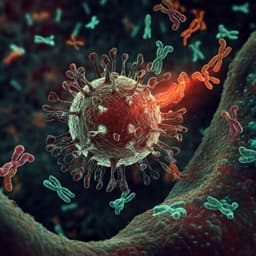
Medicine and Health
Engineered live bacteria suppress *Pseudomonas aeruginosa* infection in mouse lung and dissolve endotracheal-tube biofilms
R. Mazzolini, I. Rodríguez-arce, et al.
Engineered *Mycoplasma pneumoniae* offers a groundbreaking approach to combatting lung infections, especially ventilator-associated pneumonia linked to *Pseudomonas aeruginosa* biofilms. This transformative research led by notable authors holds promise for enhancing the effectiveness of existing antibiotics and tackling chronic respiratory conditions.
~3 min • Beginner • English
Introduction
Respiratory infections are a leading cause of global mortality and are increasingly complicated by antibiotic resistance and biofilm-associated tolerance. Biofilms are implicated in 65–80% of human infections and are common in chronic and acute pulmonary diseases, including ventilator-associated tracheobronchitis and pneumonia (VAP), where endotracheal tubes (ETTs) facilitate biofilm formation. Standard interventions such as aerosolized antibiotics often fail to eradicate biofilms. Engineered live biotherapeutics have shown promise in other body sites (primarily the gut), but no bacterial chassis has been developed for lung therapy. The study investigates whether an attenuated, engineered Mycoplasma pneumoniae—an organism naturally adapted to the human respiratory tract—can serve as a lung-specific therapeutic to disperse and kill Pseudomonas aeruginosa within biofilms relevant to VAP, while maintaining safety and enabling combination with cell wall-targeting antibiotics.
Literature Review
The paper outlines the limitations of current antibiotic therapies in biofilm-associated infections, including poor efficacy and toxicity at required doses, and highlights high VAP incidence, especially among mechanically ventilated patients with COVID-19. Prior engineered microbial therapeutics have largely targeted the gut (e.g., engineered Lactobacillus reuteri for phenylketonuria; engineered Lactobacillus or Saccharomyces for mucosal immunization). Attempts to address P. aeruginosa infections in other niches (e.g., engineered E. coli Nissle) are not applicable to the lung. M. pneumoniae is proposed as a suitable lung chassis due to: small genome, mild pathogen controllable with antibiotics, rich quantitative datasets, reduced networks minimizing interference, lack of cell wall (reduced inflammation; compatibility with beta-lactams), characterized virulence factors, available genetic tools, low recombination rates, UGA codon reassignment (biocontainment), and growth in defined serum-free media. Biofilm matrices of P. aeruginosa include Pel and Psl polysaccharides and, in mucoid strains, alginate; corresponding hydrolases PelAh, PslGh, and alginate lyases have documented antibiofilm efficacy. Pyocins (L1, S5) provide strain-specific bactericidal activity against P. aeruginosa.
Methodology
Chassis engineering and strains: The attenuated M. pneumoniae CV2 chassis was selected by deleting mpn372 (CARDS toxin) and mpn133 (cytotoxic nuclease) while retaining mpn453 (P30 adhesin) and mpn051 (GlpD/GlpO) to preserve lung colonization. A nonadherent Δmpn453 strain showed poor maintenance in lungs and was not pursued. CV2 colonization and clearance dynamics were benchmarked versus wild-type (WT) in mice.
Therapeutic payloads: Two genetic systems were integrated by transposition into the M. pneumoniae chromosome: (i) biofilm dispersal enzymes—PelAh, PslGh, and alginate lyase (A1-II/AI-II′)—comprising strain CV2_HA; and (ii) antimicrobial pyocins—L1 or S5—yielding CV2_HA_P1 (pyocin L1) and an alternative pyocin S5 variant for strain-specific coverage.
In vitro assays: P. aeruginosa strains (PAO1, NCTC 13437, BAA-2113, Boston 41501) were grown in TSB; M. pneumoniae strains in Hayflick medium. Biofilms were formed in 96-well plates (24 h, 37 °C) and treated with filtered M. pneumoniae supernatants. Biofilm biomass was quantified using Crystal Violet (OD595) and Alcian Blue (OD620); viable P. aeruginosa in biofilms were enumerated by CFU counts after treatment. Antimicrobial activity of pyocin-expressing supernatants was measured via 24–48 h growth curves (OD600). Antibiotic susceptibility tests compared effects of standard-of-care agents (e.g., piperacillin/tazobactam, ceftolozane/tazobactam, meropenem, imipenem/cilastatin, amikacin, fluoroquinolones) on M. pneumoniae and multiple P. aeruginosa strains, and on biofilm degradation (crystal violet assay).
Ex vivo ETT biofilm assay: Distal 4-cm ETT segments from ICU patients with VAP (median 11 d mechanical ventilation) harboring multidrug-resistant P. aeruginosa biofilms were hemisectioned for four treatment arms: control (medium), CV2_HA_P1 (1×10^6 cells), ceftolozane/tazobactam (C/T, 5 μg ml−1), or combination CV2_HA_P1 + C/T. After 24 h, P. aeruginosa load (log10 CFU ml−1) was quantified; resistance profiles and sequence types were characterized.
Murine studies: CD1 mice (SPF) received intratracheal (i.t.) inoculations. For colonization and safety, mice were infected with WT, CV2, or CV2_HA_P1 (up to 1×10^8 CFU) and evaluated at 2, 14, and 45 days post-inoculation (dpi) for lung CFU, histopathology (five-parameter scoring to a total of 26), and inflammatory cytokine gene expression (RT-qPCR). For efficacy, an acute PAO1 lung infection model was established in cyclophosphamide-immunosuppressed mice. Mice were infected i.t. with PAO1 (typically 1×10^3 CFU), then treated at 2 h post-infection (hpi) with i.t. CV2_HA_P1 (1×10^7 or 1×10^6 CFU), CV2, or PBS. Endpoints included lung PAO1 CFU at 26 hpi, histopathology scores, cytokine profiles, and survival over 8 dpi. Prophylaxis was evaluated by co-inoculating PAO1 with WT_HA_P1 or CV2_HA_P1 (1×10^4 or 1×10^7 CFU) and assessing lung PAO1 CFU at 8 hpi.
Molecular/proteomic methods: Plasmid assembly via Gibson; transformations by electroporation with antibiotic selection. Proteomics of strains and supernatants used LC–MS/MS (Orbitrap) with standard sample preparation and database searching. Statistical analyses included t-tests, ANOVA with post hoc tests, Kruskal–Wallis, Wilcoxon signed-rank, and survival analyses (Gehan–Breslow–Wilcoxon).
Key Findings
- Lung delivery and clearance: Intratracheal inoculation yielded higher lung loads than intranasal. WT M. pneumoniae lung burden decreased by ~2 and ~4 log10 at 4 and 14 dpi versus 2 dpi, with clearance by 14 dpi.
- Chassis selection: The nonadherent Δmpn453 strain showed significantly reduced lung CFU at 2–4 dpi vs WT, indicating adhesion is important. The CV2 chassis (Δmpn372 Δmpn133) maintained lung colonization similar to WT at 2, 4, and 14 dpi.
- Attenuation and inflammation: Histopathological total scores at 2 dpi were milder for CV2 vs WT (mean 5.8 vs 12.1). At 14 dpi, CV2 was comparable to PBS (1.7) while WT retained lesions (score ~6). By 45 dpi, lesions resolved in both groups. Cytokine expression profiles corroborated reduced inflammation in CV2.
- Dose–response (Table 1): Across inocula (10^3, 10^5, 10^7 CFU/mouse), infection rates and lung burdens for WT vs CV2 were comparable at matched doses. Example lung burdens (log10 CFU/lung, mean±SD): 10^3 dose—WT 0.9±0.2, CV2 0.8±0.07; 10^5—WT 3.3±0.9, CV2 2.4±1.1; 10^7—WT 6.4±0.7, CV2 5.9±0.7.
- In vitro antibiofilm and antimicrobial activity: CV2_HA supernatants significantly dispersed PAO1 biofilms (Crystal Violet and Alcian Blue assays; P = 0.009 and 0.007). CV2_HA_P1 further reduced viable biofilm CFU (P < 0.001). CV2_HA_P1 inhibited growth of PAO1 and showed moderate activity against NCTC 13437 and BAA-2113 but not Boston 41501; replacing pyocin L1 with S5 enabled inhibition of Boston 41501.
- Antibiotics compatibility: Cell wall-targeting antibiotics were nonlethal to M. pneumoniae but active against most P. aeruginosa strains. Antibiotics alone did not significantly degrade P. aeruginosa biofilms, whereas CV2_HA_P1 effectively dispersed biofilm; combinations with antibiotics are feasible and potentially synergistic.
- Ex vivo ETT biofilm dissolution: In 14 evaluable ETT hemisections, 24-h treatments significantly reduced P. aeruginosa loads (Kruskal–Wallis P = 0.049). Median log10(CFU ml−1) [IQR]: control 7.51 [4.44–7.51] (n=3); C/T 0.77 [0.00–2.52] (n=4); CV2_HA_P1 0.00 [0.00–0.52] (n=4); CV2_HA_P1 + C/T 0.00 [0.00–0.00] (n=3). Pairwise Wilcoxon tests significant at P < 0.05 (threshold P = 0.008).
- Safety of engineered strain: Following 1×10^8 CFU CV2_HA_P1 inoculation, lungs showed significantly fewer alterations than WT at 2 dpi; by 14 and 45 dpi, no CV2_HA_P1 CFU were detected and histopathology resembled PBS controls.
- In vivo efficacy in murine acute PAO1 infection: Treatment at 2 hpi with 1×10^7 CFU CV2_HA_P1 reduced lung PAO1 burden at 26 hpi by 3.65 log10 vs PBS and 4.39 log10 vs CV2, with significantly improved histopathology and reduced inflammatory markers. CV2 alone did not significantly reduce PAO1 vs controls.
- Survival benefit: Approximately 50% of CV2_HA_P1–treated mice survived to 8 dpi (median 7 dpi) versus median 2 dpi in PBS or CV2 groups (Gehan–Breslow–Wilcoxon P = 0.0357). Survivors in the CV2_HA_P1 group had markedly fewer lung alterations.
- Prophylaxis: Co-inoculation with 1×10^7 CFU of WT_HA_P1 or CV2_HA_P1 significantly reduced PAO1 lung CFU compared with untreated controls at 8 hpi.
Discussion
The study demonstrates that an engineered, attenuated M. pneumoniae (CV2) can function as a safe, lung-adapted live biotherapeutic to combat P. aeruginosa biofilm-associated infections. By combining targeted biofilm-dispersing enzymes with strain-tunable antimicrobial pyocins, the platform achieves both matrix disruption and bacterial killing, addressing key mechanisms of biofilm tolerance. The absence of a cell wall in M. pneumoniae reduces inflammatory potential and allows concurrent use with cell wall–targeting antibiotics, enabling synergistic strategies where antibiotics alone inadequately affect biofilm biomass. Ex vivo ETT assays on multidrug-resistant clinical biofilms and in vivo murine data confirm robust reductions in pathogen load, improved lung pathology, and enhanced survival, supporting the translational potential for VAP and related respiratory biofilm diseases. The capacity to swap pyocins extends spectrum coverage across diverse P. aeruginosa strains, highlighting modularity. Overall, these findings address the gap in lung-directed engineered bacterial therapeutics and suggest a viable path for localized, sustained delivery of anti-biofilm and antimicrobial factors in the respiratory tract.
Conclusion
This work establishes an engineered M. pneumoniae chassis (CV2) as a lung-specific live biotherapeutic that safely colonizes the respiratory tract, disperses and kills P. aeruginosa within biofilms, and synergizes with standard-of-care antibiotics. The CV2_HA_P1 strain significantly reduces bacterial burden and pathology in an acute murine pneumonia model, improves survival, and effectively dissolves biofilms formed on patient ETTs ex vivo. The modular design enables tailoring antimicrobial payloads (e.g., pyocins L1 or S5) to target-specific P. aeruginosa strains. Future research should evaluate efficacy in chronic and polymicrobial biofilm models, expand payload repertoires for broader pathogen coverage, optimize dosing and delivery regimens (including prophylaxis), and conduct safety and efficacy studies in larger animals and clinical trials to confirm translatability.
Limitations
- The in vivo efficacy was demonstrated in an acute, immunosuppressed murine PAO1 infection model; results may differ in chronic or polymicrobial infections and in immunocompetent hosts.
- Antimicrobial activity showed strain specificity (e.g., pyocin L1 was ineffective against P. aeruginosa Boston 41501), necessitating tailored payload selection (e.g., pyocin S5) for broader coverage.
- Ex vivo ETT experiments, while clinically relevant, involved a limited number of samples and short treatment duration; in vivo human efficacy and safety remain to be established.
- Long-term colonization dynamics, potential host immune responses beyond 45 dpi, and effects of repeated dosing were not fully characterized.
- The study focused primarily on P. aeruginosa; applicability to other respiratory pathogens and mixed biofilms requires further validation.
Related Publications
Explore these studies to deepen your understanding of the subject.







